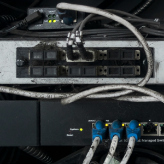 Your heart is always there beating away 24-hours a day. This is also an apt description for your servers. They are always working, ensuring your business stays operational even if you don’t notice it. However, it’s not unusual for business owners to overlook their servers as most times it is a simple case of out of sight, out of mind. This is a dangerous way of thinking because once your servers go down, you will start losing money and maybe even go under. Even if your servers seem to be running smoothly, do yourself a favor and consider these three questions.
Your heart is always there beating away 24-hours a day. This is also an apt description for your servers. They are always working, ensuring your business stays operational even if you don’t notice it. However, it’s not unusual for business owners to overlook their servers as most times it is a simple case of out of sight, out of mind. This is a dangerous way of thinking because once your servers go down, you will start losing money and maybe even go under. Even if your servers seem to be running smoothly, do yourself a favor and consider these three questions.
When do my servers need to be replaced?
This is a difficult question to answer but there are two factors you will want to consider – age and performance. The useful life of a server tends to be around three years. After the third year, your support costs to maintain them will rise drastically. While it’s not unheard of for servers to function properly beyond year three, relying on them beyond this point can be risky as their health can’t always be guaranteed. This means you will have to deal with costly repairs and possible downtime that you can’t predict.
Performance is another factor when it comes to servers. Even if your servers are only a year old, it doesn’t make sense to keep them around until year three if they are slow and are costing a fortune to maintain. It’s important to do a cost benefit analysis in these situations and look at how much money you will lose in repairs and downtime and then compare it to the cost of buying new hardware.
Do I have an alternative to buying new servers?
Believe it or not, the answer to your server problems might not necessarily be purchasing more physical hardware. One way to avoid this is by embracing virtualization. This process allows your servers to be stored and maintained off-site with everything being delivered to your office via the internet. There are two notable benefits of virtualizing your servers. The first is that you don’t have to spend a bunch of money buying new equipment. The second is that virtualization is a scalable technology meaning you only pay for the space you use. For instance, if you only need two and a half servers, you can do that. This is in contrast to having physical equipment which would require your business to either make do with two servers or splurge and buy the third one even if you didn’t need all of that space.
Of course there are a few things you need to consider before making the switch to server virtualization. One of the biggest issues is security. You’ll have to ask yourself if you feel comfortable keeping all of your data off-site. While this isn’t a concern for some companies, others don’t see this as palatable. There are several workarounds to this issue including the hybrid option where you keep sensitive data on-site and everything else off-site.
Can I do anything to prevent a full-scale server replacement?
Yes. It’s certainly possible for you to buy some time and give your current servers additional life, but these are short term fixes, not long term solutions. Server upgrades are a good place to start if your servers are less than three years old but are degrading in performance. Adding additional CPUs or memory may increase server performance at a fraction of the cost of buying new servers.
You can also utilize old servers for non-critical workloads. It’s possible to extend the life of servers that may have four of five years of wear and tear on them via repurposing. Instead of swapping out all of your servers, use the old ones for the non-critical processes and purchase new ones to handle critical workloads. This will help you get a better ROI on your technology while avoiding a wholesale hardware purchase which could cripple your budget.
If you have any questions about your servers and how you can increase performance, get in touch with us today. We can help you procure new hardware or show you the benefits of virtualization.

 Implementing Business Intelligence (BI) software and other tools can help your company grown by leaps and bounds. However, it has to be planned for with the proper level of diligence and care to truly be beneficial to your business. Haphazardly installing BI software can result in an expensive misstep that sees you fall behind the competition. But with well executed BI planning and implementation, your company can grow in ways never imagined.
Implementing Business Intelligence (BI) software and other tools can help your company grown by leaps and bounds. However, it has to be planned for with the proper level of diligence and care to truly be beneficial to your business. Haphazardly installing BI software can result in an expensive misstep that sees you fall behind the competition. But with well executed BI planning and implementation, your company can grow in ways never imagined. When your employees see snow on the ground, the thought of a day off immediately pops into their heads. Of course your customers are still reliant on you to provide the goods and services they have come to expect from your business. Before a storm hits, you should be communicating with both staff and clients to inform them of the situation. This will ensure your business doesn’t miss a step should inclement weather head your way this winter.
When your employees see snow on the ground, the thought of a day off immediately pops into their heads. Of course your customers are still reliant on you to provide the goods and services they have come to expect from your business. Before a storm hits, you should be communicating with both staff and clients to inform them of the situation. This will ensure your business doesn’t miss a step should inclement weather head your way this winter.